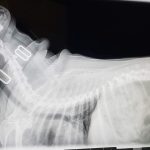Our 10 year old Beagle Bassett hound mix has been down since last Wednesday. She had what we thought was a seizure, and couldn’t get up after. We took her to the vet, and they kept her but said that she wasn’t giving any indication to where the pain was or where the infection might be (a blood panel revealed high WBC) Sent her home with phenobarbital and clindamycin for the infection. Fast forward to yesterday, they decided to do an x ray and discovered she has degenerated vertebrae that have fused. They gave us prednisone and methocarbamol and advised us to call in on Friday if no improvement. Our poor girl can’t get up hardly at all, and the vet isn’t giving me any information as to what caused this, if it’s curable or manageable. I don’t know what I’m up against and a 2nd opinion isn’t something we can afford right now.
Comments
I have a 13 yo female domestic short hair. She has a very large ventral hernia and is losing weight very fast in Oct she was 6.9lb, in Nov she was 6.4lbs. The surgery is $2300 which I cannot afford. She gets diarrhea after eating and sleeps ALOT. I hate to put her down, I wish she would go naturally but I dont want her to suffer & need advice. Please help.
Comments
My 3 yo male nuetered tuxedo cat Kenobi was diagnosed with FIC by the ER DVM yesterday with no blockage. He is peeing just a dime size at a time. Should I also give him Apple Cider Vinegar as his PH was 7.0 ? Other than his urinary levels, red blood cells in his urine, struvite crystals, his blood work was good with no infection. The ER DVM gave him ; Buprenorphine, Prazosin, & Gabapentin. We have changed his food to all wet Royal Canin Urinary SO from mainly kibble with some wet. We think the stressor was the absence of our 19 yo tabby Tinkerbelle we had to help cross over 2 weeks ago. Should I get Kenobi a companion kitten to replace Tinkerbell? We also are buying a water foundation as he does not drink water enough.
Comments
I took my male cat to the vet and they told me he need a catheter to help him pee because he has a blockage. They suggested me to take him to a vet ER overnight but unfortunately I can’t afford it. They gave me the option of bringing him tonight Saturday with the catheter and take him Monday morning so they can take it off. Any helpful tips so I can properly take care of him ?
Comments
I am in Dallas, TX. My 6 years old male cat Simba had urinary blockage which was cleared by my vet. Now, my vet wants me to go for PU surgery. Does anyone know affordable vet clinic in dallas area for the surgery?
Thx!
Comments
I recently had to put my kitty to sleep. He was 2 1/2 years old and dealing with leaking at times, then blockages. He had this issue for over a year. We switched him to the Purina prescription wet cat food for Urinary Tract issues. He wasn’t a fan of drinking water from a bowl, so we added 1-2oz of water to his wet food. His total water intake was about 8-9oz of water daily (He was only an 8lb cat and the water also includes what the canned food provided.) He was hospitalized 3 or 4 times — the last time he was in the ER for 14 days. The vet didn’t put the catheter in correctly for the first time — causing major urine scolding on his rear end. They did the catheter correctly for another 7 days. A month later, blocked again. With his issue, PU surgery was not an option. His blockages and urethra damage was too far up close to the bladder — this was told to us by multiple vet opinions. With multiple vet opinions, the only suggestion with the last blockage was to do the same 7 day catheter to help the urethra repair again. Our primary vet was honest with us and said that this option would help him, but wasn’t sure if we would ever have a permanent solution to his blockages. In total, we probably spent upwards of $15,000 with all of these issues over the year (The 14 day emergency room stay was $6,500). Money was not a factor for my wife and I — If I knew we could actually fix him and give him a good quality life, I couldn’t put a price tag on it. With a lot of discussion, we decided it was best to put him to sleep. Feeling good for a weeks or a month, then blocking again, then lengthy procedures wasn’t fair for him. It’s been 3 days since we put him to sleep and I can’t help but feel guilt like we didn’t do everything we possibly could do. I did so much deep diving in google for ANYTHING — I read up on stents, bypasses, etc. I truly don’t think there was anything else we could. It would help me feel better if you could give you opinion on if we did everything we could. Thank you!
Comments
My min pin is diabetic. He’s been having some digestive issues getting his diet right with his insulin. I’ve noticed the last month or so that his butt has started getting puffy. Last night it was a little red but, he hasn’t been scooting or biting at it. I also have noticed some slimy covering on his stool at times. I’ve been giving him probiotics and since then his poo has been the color of the probiotics, like a chicken boil union cube.
Comments
5 Yr old rescue cat named Maew. Indoor/outdoor. Severe mega colon with constipation/ostibation related to nerve damage from having her tail removed by a dog when she was a kitten.
We have had her in and out of the vet many times for enemas and have done everything we can to keep her going. Laxatives, lots of exercise, diet changes We are out of options and considering colon surgery.
I need a magical diet/food remedy to help her mega colon issues. She actually did well for a few years on high fiber dry food. But that time is over and we are trying every food option to keep her hydrated and avoid colon issues.
We do regular manual palpitation also.
Help help help!
She’s always been there for us with an encouraging head boop and now we have to be there for her. We will never give up! She’s a survivor and deserves much more time with our family
Comments
Saturday I was working in the yard and later came across poison ivy. My 6 year old lab was out with me and I’m worried I touched his toy with poison ivy hands or his toy touched poison ivy. Should I be concerned that he will get poison rash in his mouth?
Comments
Our 5 month old male kitten has severe obstipation. After xray he was admitted to Vet Hospital on Mon Nov 7th. Treatment has been sub cutaneous fulids ( no IV’s) several saline enemas with sedation, oral miralax, and recent start of lactulose. No stool results as confirmed by xray. My question is 1) can a mineral oil enemas soften the hardened stool and 2) is there a way to aspirate the stool with a small suction catheter. I have limited finances and cannot keep him in the hospital much longer. Thanks for any suggestions you might have.










Hello,
I would probably go find a different vet and ask for more help. It doesn’t sound like your vet is helping you enough. I also think that a full patient care conversation is warranted. I talked about how to help manage these guys wrt feeding peeing pooping ambulating and pain meds. I also talk about methocarbamol as I think these guys need this. Also ask about gabapentin and acupuncture.
I have a lot of information on my blog and YouTube channel. Kmdvm.blogspot.Com search Ivdd.
Thank you so much. Does this seem like IVDD to you? That’s how I came across your blog, and to me, the symptoms you describe sound a lot like what our girl is experiencing.